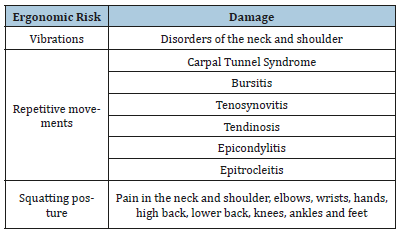- Submissions

Full Text
COJ Reviews & Research
Occupational Health and Ergonomic Risks in Brick Manufacturers
Imelda OM1*, Curiel R2, Contreras R3 and Gil G4
1,3,4 Populational Health Sciences Department, Mexico
2 Public Health Department, Mexico
*Corresponding author:Imelda OM, Populational Health Sciences Department, Mexico
Submission: December 12, 2018;Published: March 22, 2019

ISSN: 2639-0590 Volume2 Issue1
Abstract
In the present review it is intended to synthesize the main theoretical components of occupational health and empirical work related to ergonomic risk factors in people who work as brickmakers. With the purpose of provide future research horizons to those who study this line of research.
Introduction
Brick making plants are one of the most polluted workplaces in western Mexico that cause respiratory, gastrointestinal, reproductive, psychosocial, dermatological and musculoskeletal disorders. Despite the multiple health problems faced by brick kiln workers, the existence of social security services and health care at work is nil or not very accessible. Brick making is a laborious job and represents a series of occupational hazards that can be preventable, this work is often carried out by all members of families, including women and children, which exacerbates the problem and becomes a need for attention to these populations with a public health perspective.
Musculoskeletal disorders in occupational health
Musculoskeletal disorders are an example of the damage to health that can be caused by inappropriate postures or other characteristics of an inappropriate workspace. These disorders are defined as a group of conditions that involves the nerves, tendons, muscles and supporting structures such as intervertebral discs and that represent a wide range of disorders, which may differ in terms of severity and possible acute or chronic effect. Some of them are: Carpal tunnel syndrome, tension syndrome in the neck, low back pain, among others [1]. The World Health Organization has indicated the serious problem represented by the increase in pathologies inherent to and associated with the musculoskeletal system, for this reason the period between the years 2000-2010 has been declared the Decade of Bone and Joints [2].
Also, MSD (musculoskeletal disorders) are common among workers in the brick industry, where intense physical work is required, often requires inappropriate work postures for prolonged periods, significantly increasing morbidity and significantly decreasing the work capacity in this population [3]. In the labor process of manufacturing artisanal brick, the following activities are identified: Obtaining raw material, Transport of raw material (water, clay, manure, sawdust and maguey bagasse), Clean the work area, Dosage, Mixed, Molded, Drying, Raw stacking, Assemble furnace, Lined furnace, the process of heating them, Cooled from the furnace, Scraped off, Loading of bricks for transport and sale/distribution. The brick industry includes different unfavorable actions and these actions give rise to various types of musculoskeletal disorders in the body, especially in the lower back, knees, shoulders, neck and wrist.
Musculoskeletal disorders and ergonomic risk factors
There are many studies that relate MSD to work in different parts of the world. The main findings that were identified in the review of the literature on the subject are presented below. Globally, MSD are the leading cause of work-related diseases, accounting for more than 33% of all occupational diseases reported recently in the general population and 77% with construction workers [4]. The MSD are associated with the factors of force, posture, repetitive movement and vibration. The level of exposure to the physical workload can usually be assessed with respect to intensity (or magnitude), repetitiveness, and duration. MSD can affect the soft tissues of the body, tendons, muscles, nerves of the hands, wrists, elbows, shoulders, neck and lower back [5].
In a study in India on women brickmakers Sahu & Sett [6] identified that there was a significant difference in the presence of pain between women who worked as molding and those who did as transporters, being more frequent to be experienced in the areas high of the body of the transporters for example the head, neck, arms, shoulders. Likewise, in another study in India it was reported that there was a significant difference in the presence of pain among adolescent workers who carried more than 200 bricks compared to those who carried less than 200 [7]. In Pakistan, a comparative study was carried out, where the presence of TME was reported in the exposed group and in addition a significant difference of presence was identified with seniority in the work, found as the parts of the body most affected the neck, shoulders, elbows, wrists, hands, high back, lower back, knees, ankles and feet.
In Latin American countries, similar findings have been reported. Vargas et al. [8] identified in a study carried out in Colombia that brickmakers, in addition to presenting TME due to inappropriate postures, lacked the use of safety equipment in their work activities. It´s also mentioned that disorders of the shoulder region are frequent problems both in the general population and in the workforce. Up to a third of women and a quarter of men complain of pain in the neck and shoulders every day or every other day. It is estimated that the prevalence of shoulder tendinitis in the general population is around 2%. In workers of both sexes of the United States, the prevalence of shoulder tendinitis has been calculated up to 8% in those exposed to very repetitive movements or of great strength with the hands [9].
In several studies, MSD have been associated with repetitive movement, excessive force, forced and or sustained postures, the transmission of vibrations or low temperatures [10-12]. Other studies indicate an association of carpal tunnel syndrome, bursitis, tenosynovitis, tendinosis, epicondylitis, epitrocleitis with activities where there are repeated movements, sustained overloads, vicious postures, vibrations or overexertion exercises [13]. According to the data provided by the Department of Ecology of the Municipality of Tonalá in [14], 336 brick factories have been inventoried (Ministry of the Environment for Sustainable Development, 2011). Which visualizes a high magnitude of the aforementioned labor and health phenomenon. The damage to health by ergonomic risk factors are diverse and depend on the type of activity performed improperly. It is important to adapt each activity of the brickmakers to their person, considering their height, build, weight, age and sex, in order to avoid musculoskeletal conditions, strains or sprains and others. Previous studies have identified causal relationships between highly repetitive work and musculoskeletal disorders of the neck and shoulder/shoulder, repetitive work involving continuous movements of the arms or hands, affects the neck/shoulder muscles and generates loads in the neck/shoulder area [15]. Finally, it has also been a document that there are ergonomic risk factors in the brickwork, related to physical wear and tear, because brick making is a strictly manual activity, from obtaining the raw material to obtaining the final product that is the brick [16] (Table 1).
Table 1:Ergonomic risks and health damage due to the work activity.

Conclusion
From the review of the main findings on health and musculoskeletal disorders in brick makers. The preventive measures proposed by Public Health, in the face of ergonomic risks in these work spaces, should be aimed at establishing greater comfort and safety in the workplace. Specifically, it is recommended that during the manufacture of bricks:
1. The machines are designed so that when they are used, they favor the acquisition of a good posture. It is necessary that they can be elaborated and conditioned according to the individual characteristics and the professional qualification of the workers. The design of the tools must adapt to the function for which they are required and to the natural posture of the human body.
2. There is a correct distribution of time in which repetitive activities are performed and there is an adequate management of body postures.
3. The personal characteristics of each worker are considered to assign tasks, that is to say, that are commensurate with their weight, height, age, sex and level of health.
4. The control of exposure to other factors of a physical nature, for example, to radiation, lighting, noise and temperature, is guaranteed.
It is also considered that short and repeated pauses are more effective; and that night work is, ergonomically speaking, the least recommended, because it affects the worker’s health and performance.
References
- National Institute for Occupational Safety and Health (1997) Musculoskeletal disorders and workplace factors. A critical review of epidemiologic evidence for work-related musculoskeletal disorders of the neck, upper extremity, and low back. Cincinnati: DHHS (NIOSH) Publication.
- Babini A (2019) 2000-2010 Década del hueso y la articulación: lecciones aprendidas. Rev Arg Reumatol 22(11): 06.
- Inbaraj LR, Haebar OJ, Saj F, Dawson S, Paul P, et al. (2013) Prevalence of musculoskeletal disorders among brick kiln workers in rural Southern India. Indian Journal of Occupational and Environmental Medicine 17(2): 71-75.
- Fernando WIB, De Silva PV, Sundarapperuma SMTD (2017) Prevalence of work related musculoskeletal disorders in brick industry workers in Chilaw Sri Lanka. Journal of the Ruhunu Clinical Society 21(1): 9-15.
- Das B (2014) Prevalence of work-related musculoskeletal disorders among the brick field workers of West Bengal. Arch Environ Occup Health 69(4): 231-240.
- Sahu S, Sett M (2010) Ergonomic evaluation of tasks performed by female workers in the unorganized sectors of the manual brick manufacturing units in India. Ergonomics SA: Journal of the Ergonomics Society of South Africa 22(1): 2-16.
- Sahu S, Sett M, Gangopadhyay S (2010) An ergonomic study on teenage girls working in the manual brick manufacturing units in the unorganized sectors in West Bengal, India. J Hum Ergol 39(1): 35-44.
- Vargas C, Calderón DM, Fierro Y (2008) Condiciones ergonómicas posturas inapropiadas de los trabajadores de la ladrillera Conuco del municipio de Garzón. Garzón: Universidad Surcolombiana.
- Messing K, Kilbom A (2001) Standing and very slow walking: Foot painpressure threshold, subjective pain experience and work activity. Appl Ergon 32(1): 81-90.
- González J, Valero H, Caballero EL (2004) Estudio de riesgos de lesiones músculo esqueléticas en las fábricas de pinturas vitral y de helados Coppelia. Revista cubana de Salud y Trabajo 5(2): 31-40.
- Hussain T (2004) Musculoskeletal symptoms among truck assembly workers. Occupational Medicine 54(8): 506-512.
- Da Costa BR, Vieira ER (2009) Risk factors for work-related musculoskeletal disorders: A systematic review of recent longitudinal studies. Am J Ind Med 53(3): 285-323.
- Sáez V, Arriagada C, Marco K, Manríquez O (2004) Prevalencia de lesiones músculo-esqueléticas y factores de riesgo en trabajadores de plantas procesadoras de crustáceos en Chile. Ciencia y trabajo 6(13).
- Secretaría de Medio Ambiente parael Desarrollo Sustentable (2011) Monitoreo de calidad del aire. Informe técnico final. Fraccionamiento Hacienda Real, Tonalá Jalisco. Tonalá: Dirección del Sistema de Monitoreo Atmosférico.
- Joshi SK, Dahal P, Poudel A, Sherpa H (2014) Work related injuries and musculoskeletal disorders among child workers in the brick kilns of Nepal. International Journal of Occupational Safety and Health 3(2): 2-7.
- Romero JJ, Barraza JH, González NA, Flores JM, Romero D, et al. (2013) Estudio observacional sobre los riesgos y exigencias laborales que encaran los fabricantes de ladrillos en el estado de Nayarit. Estudio de caso en la comunidad de Puente de San Cayetano en la ciudad de Tepic, Nayarit, México. Revista Waxapa 1(8): 49-55.
© 2019 Imelda OM. This is an open access article distributed under the terms of the Creative Commons Attribution License , which permits unrestricted use, distribution, and build upon your work non-commercially.
 a Creative Commons Attribution 4.0 International License. Based on a work at www.crimsonpublishers.com.
Best viewed in
a Creative Commons Attribution 4.0 International License. Based on a work at www.crimsonpublishers.com.
Best viewed in 







.jpg)






























 Editorial Board Registrations
Editorial Board Registrations Submit your Article
Submit your Article Refer a Friend
Refer a Friend Advertise With Us
Advertise With Us
.jpg)






.jpg)














.bmp)
.jpg)
.png)
.jpg)










.jpg)






.png)

.png)



.png)






